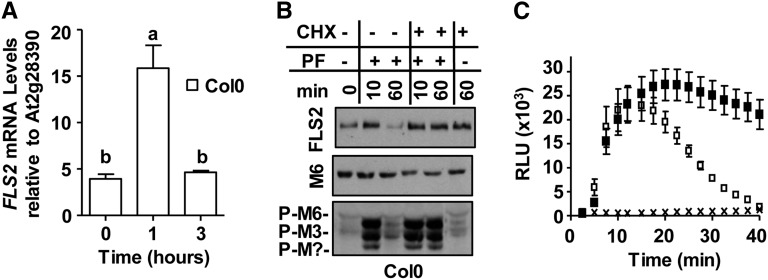Figure 7.
Ligand-induced degradation of FLS2 and attenuation of flg22-signaling responses is impaired by treatment with the protein synthesis inhibitor CHX. A, Flg22-induced expression levels of FLS2 mRNA. Col-0 leaf strips were elicited for 40 to 45 min with 1 μm flg22, washed, and incubated in the absence of flg22 until indicated times. Samples were processed for qRT-PCR using At2g28390 as the reference gene. For each time point, results of at least three independent experiments containing three biological and three technical repeats are shown. Values are mean ± se, and means with different or the same letters are significantly different or not significantly different, respectively (two-tailed Student’s t test, P ≤ 0.003). B, Effect of CHX on ligand-induced degradation of FLS2 and flg22-signaling responses. For immunoblot analyses, total protein extracts were probed with αFLS2, αP-p44/42 MAPK, or αMPK6 (M6) as in Figure 4. C, Effect of CHX on flg22-induced ROS production. Col-0 leaf disc halves (n = 24 per treatment) were cotreated in the presence (black squares) or absence (white squares) of 50 µm CHX and elicited with 1 µm flg22 at 0 min. Mock-treated samples (x) were treated with CHX and DMSO (instead of flg22) at 0 min (n = 24 per treatment). To allow for correct comparisons, ROS experiments shown in C were performed in the same 96-well plate at the same time. RLU, relative light units; P-M?, phosphorylated unknown MPK.

